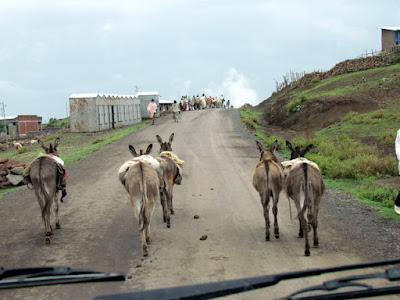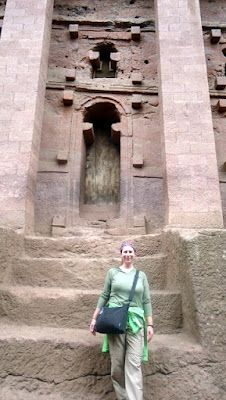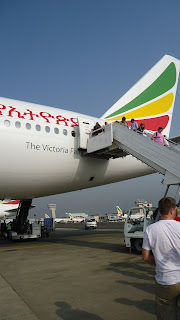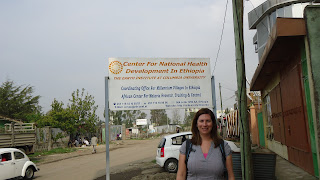I've gone ahead and posted additional pictures that I've taken throughout my first month here to a Picasa album if you are interested in seeing a bit more of my experience:
Sunday, July 31, 2011
Thursday, July 28, 2011
Weekend in Lalibela
So this past weekend I had my first great adventure outside of Addis! I went with my two roommates, and fellow PULSE volunteers, Bridget and Sarah to visit Lalibela, in the highlands of Ethiopia. Lalibela is a holy Ethiopian city that is still a place of pilgrimage for Ethiopian Orthodox Christians.
Bridget has found a really interesting video that talks a bit about Lalibela’s history, legends, and present-day state:
After the stressful ride to the top, which I did complete!, I decided it would be best for me to walk the rest of the way down along with the mule men, and our guide. Unfortunately it did rain most of the way down, making what was difficult to navigate on the way up even muddier and slipperier on the way down! Very thankfully, with a bit of assistance, I made it all of the way down safely, without falling. Back safely to our hotel we were able to take a nice view back up to where we were.
Bridget has found a really interesting video that talks a bit about Lalibela’s history, legends, and present-day state:
We flew into the Lalibela airport, which was still good 30 minute or so winding mountain ride to the town. It was a beautiful ride and packed almost the entire way with people and animals making their way from the villages into town for the big Saturday market.
It was great to escape the city for a bit of fresh air and a bit more relaxed atmosphere. It was truly a different feel than being in the city here. The local homes were very neat and our hotel was a glorified version of them.
 |
| A typical style local home |
 |
| Our hotel - each building had a top and bottom floor room |
The hotel definitely was a treat and lived up to its advertised promise of 24-hour hot water availability, and even had decent water pressure!
The city is most well-known for its rock-hewn churches, carved down into the red volcanic rock in the 12th-13th century. They are truly a fascinating site and now a UNESCO world heritage site. There is a stark contrast between the very dated churches and the modern styled protective coverings above them.
There is also a beautiful contrast between the red rock and the brightly colored lichens now covering parts of them.
The most well known of the churches in the city is the church of St. George. It is very impressive in height and is shaped like a cross from top to bottom.
Many of the churches are connected by a fascinating maze of tunnels and pathways and seemingly hidden connectors. Luckily we had a great guide who led us through.
It also seemed like a fantasy world with giant sized steps and minituare sized doorways that made working our way around a fun challenge.
Although I did find one tunnel which was the perfect height for me!
In addition to spending two half-days touring the churches in Lalibela, we spent one very long morning making our way up the mountain to the Asheton Maryam monastery…by mule! It was about a 7km climb and tops out at about 4,000m. As some of you may know, I am not a fan of horse riding and equally disliked the mule ride, not surprisingly. What was surprising was the terrain on the way up - it was even more treacherous than I had imagined it would be! There were rocky cliffs, loose rocks, mud and all. I was so nervous the entire way up, holding on tight to my mule, that I didn't take any photos, but I have a few pictures from my fellow travelers to share, and those that I was able to get at our stop on the way up, and while at the top.
 |
| Our early morning pick-up outside of the hotel! Three mules and three mule men |
 |
| A very rocky path ahead at this point |
 |
| The view from part way up the mountain |
 |
| Not all of the way up yet, but the town is looking very small in the distance below |
 |
| Almost there! After paying the first priest our entrance fee, we got to climb up these rock steps, into the dark crevice at the top to get up to the monastery |
 |
| The outside of the monastery itself was not quite as impressive as the views going up |
 |
| Inside the dim monastery, a very cool priest wore Bridget's sunglasses to protect his eyes from the flash as he showed us some of the monastery's treasures |
 |
| There was a large crowd of locals outside, as a church meeting was wrapping up |
 |
| They really enjoyed being able to look at themselves after they'd been in a photo |
 |
| Here's my mule on the descent...having a nice easy ride as I trekked my own way down on my own two feet |
After the stressful ride to the top, which I did complete!, I decided it would be best for me to walk the rest of the way down along with the mule men, and our guide. Unfortunately it did rain most of the way down, making what was difficult to navigate on the way up even muddier and slipperier on the way down! Very thankfully, with a bit of assistance, I made it all of the way down safely, without falling. Back safely to our hotel we were able to take a nice view back up to where we were.
 |
| Zoomed in a bit closer on where we went... |
 |
| Zoomed in even further. It was the white rock face here, where we had climbed to |
It was a fantastic weekend get-a-way, and impossible to capture all of the striking views we saw, but if you want to see more of the trip, I’ve posted the photos here: Lalibela Pictures
Tuesday, July 26, 2011
Center for National Health Development in Ethiopia
So a full three weeks in, here now, I want to spend some time andshare a bit more about the Center for National Health Development in Ethiopia (CNHDE), where I will be working these six months. The CNHDE is a Project of the Earth Institute at Columbia University and is involved in activities focusing on supporting the following:
- Implementation of the Health Extension Package (HEP)
- Achievement of Millennium Development Goals in Ethiopia
- Millennium Villages in Ethiopia
- Malaria Quick Impact Initiative
The Health Extension Program
A large part of the Center's work is to provide support for the HEP, government program that aims for universal coverage of primary health care. The program’s priorities are the prevention and control of communicable disease with active community participation, and the goal of providing equitable access to health services. To achieve this, roughly 15,000 health posts will be needed, and a total of about 30,000 HEWs will need to be deployed to the 15,000 villages (average population of 5,000 each) for a total coverage of over 12 million people throughout the country. By 2007, a majority (94%) of villages had health post infrastructure specifically built for the provision of HEP.
With the cooperation of the Federal Ministry of Health, the CNHDE will also serve as an independent evaluator of the HEP and other health programs by engaging in the assessment of the progress of HEP implementation and related activities of the general health system. Baseline survey data was captured in 2005 and 2007, with more recent and complete survey data now available from 2010. It is survey data from these efforts that I will be working on during my time here.
For more information, please visit: http://cnhde.ei.columbia.edu/
Wednesday, July 13, 2011
Ethiopian Cultural Center
So to cap off my first work-week here, last Friday one of my roommates (Bridget) and a co-worker from here (Hiwot) accompanied me to my first Ethiopian Cultural Center experience...and it was quite the experience! There are numerous such cultural centers throughout the city here, although we went to the one closet to us - Yod Abyssinia - only several blocks away from our temporary home. There were more "feringis" (foreigners) there than I had seen the entire week. It was adorned with many lights outside and very extensively decorated on the inside - it kind of reminded me a little bit of a "Disneyworld"-type feel.
 |
| Me outside of the cultural center |
 |
| A view of the ceiling inside |
 |
| Bridget and Hiwot enjoying themselves inside |
As far as food goes, we opted for the buffet that night so that we could try a multitude of foods and since we had the luxury of having a native with us to help explain what it was we were choosing and eating (many thanks Hiwot!). I tried a few new things that I liked there, including some meat dishes (chicken and lamb) that are not as always commonly available here, as there are many fasting days where those of Ethiopian Orthodox faith (the majority of people here) eat a vegan diet. Ironically, later last weekend, when trying to explore a bit more about the city, I was looking on TripAdvisor.com and the Yod Abyssinia was the #1 rated restaurant in all of Addis! In addition to the food, we tried a couple of Ethopian beers, including St. George (by and far the most popular here, like the Bud or Miller of Ethiopia) and also a Dashen beer, which I preferred!
Finishing off the meal, we also had some coffee, which was served with popcorn and some burning incense (both of which are involved in the traditional Ethiopian coffee ceremony)
In addition to the food and drink, the evening went on with a lot of entertainment: a band, singers, and dancers performing musical and dance numbers representative of many of the different cultural regions throughout the country of Ethiopia. There is no easy way to describe them, and since the pictures don't do them justice, I'm attaching several short video clips of different dances from various regions:
Fortunately for the entertainment of my roommate and co-worker, there was an audience participation portion towards the end of the evening which I got pulled into. They sure do know how to move their shoulders and necks and jaws in some amazing ways. As you can see, my performance is quite amateur and luckily near the end Hiwot jumped in with some of her dance expertise...I obviously need a lot more practice! :-)
Well....all I can say is that at least my audience participation was down by my seat on not on stage like these guys, with their very interesting dance moves:
All-in-all, it was a fun night out to start off my first full weekend here! The rest of the weekend was quite a bit more low-key, checking out some of the local neighborhood restaurants and shops, continuing to get settled in and relaxing. However, I do know that I will have to work on my shoulder movements before we return to another cultural center here soon...
 |
| Dashen Beer |
 |
| The coffee spread |
 |
| They left the incense to burn, while we drank the coffee. The smell reminds me of church! |
 |
| The band |
Fortunately for the entertainment of my roommate and co-worker, there was an audience participation portion towards the end of the evening which I got pulled into. They sure do know how to move their shoulders and necks and jaws in some amazing ways. As you can see, my performance is quite amateur and luckily near the end Hiwot jumped in with some of her dance expertise...I obviously need a lot more practice! :-)
Well....all I can say is that at least my audience participation was down by my seat on not on stage like these guys, with their very interesting dance moves:
All-in-all, it was a fun night out to start off my first full weekend here! The rest of the weekend was quite a bit more low-key, checking out some of the local neighborhood restaurants and shops, continuing to get settled in and relaxing. However, I do know that I will have to work on my shoulder movements before we return to another cultural center here soon...
Sunday, July 10, 2011
Millennium Development Goals
Before I get into much more detail about where I am working, specifically, I wanted to share about the Millennium Development Goals (MDGs), as these are what the Center for National Health Development in Ethiopia (CNHDE) are supporting. For much more detail on these, if you are interested, please see the UN’s MDG website: http://www.un.org/millenniumgoals/
The goals were initially endorsed at a UN summit in September 2000, and are targeted at freeing humanity from extreme poverty, hunger, illiteracy and disease. They are the world's time-bound and quantified targets for addressing extreme poverty in multiple areas including:
As an example, a specific target for the "Child Health" goal is to reduce by two-thirds, between 1990 and 2015, the mortality rate of children under five years old. As far as progress thus far, the number of deaths of children under the age of five declined from 12.4 million in 1990 to 8.1 million in 2009, meaning that nearly 12,000 fewer children are dying each day. Areas where specific attention is being paid to have a continued impact in this area include special efforts to fight pneumonia, diarrhea, and malaria while improving nutrition for children. (The Millennium Development Goals Report 2011)
Another example is the sixth goal which is a broader health goal to “Combat HIV/AIDS, malaria and other diseases”, with multiple targets, including halting by 2015 and beginning to reverse the incidence of malaria and other major diseases. Globally, deaths from malaria have decreased by an estimated 20% - from nearly 985,000 in 2000 to 781,000 in 2009. Meanwhile, the number of malaria cases rose from about 233 million in 2000, to 244 million in 2005, and then decreased to 225 million in 2009. Major decreases in the number of malaria cases are associated with intensive control efforts, however, 90% of all deaths from malaria still occur in sub-Saharan Africa and most of these deaths are among children under age five. (The Millennium Development Goals Report 2011)
I hope that this gives a bit of a broad perspective on some of the health challenges and issues that I will be addressing while working with the CNHDE…and more to come on some specifics of CNHDE and how these goals are being supported in Ethiopia, specifically.
Thursday, July 7, 2011
My Commute
Prior to my arrival, my roommates were able to film a bit of our commute to the office, so I thought I'd share.
A typical commute to work is about a ten minute walk from our house, and then a ten minute minibus ride towards the office. Part of the walk to where we pick up the minibus passes by a very large Ethiopian church. The sidewalks in front of the very large church complex (note the fence with crosses) are often lined with beggars and what appear to be homeless. Many of them know little English, and you can hear here what is a common greeting, especially from children - "Hello Sister"
After our walk, we hop on a minibus, which is essentially a communal taxi on a set route. They are blue and white vans (you will see others passing by in the video) and they are run by a driver and usually a boy or young man who will stay in the back and hang out the window calling out which route the minibus is going. In the video you will hear him call "hayulet" for our route on the way to work. In addition this second worker will collect money from you once you are on the mini bus and also let the driver know when to stop when called out by a passenger - if not at a standard spot. Legally, here, these minibuses are meant carry up to twelve people, but you will often see many more crammed in. They are definitely an affordable way to catch a ride with our one-way fare being somewhere between 1-3 birr (the currency here), depending on how far we go, with 1 birr=$0.06. You will see that the private blue and white taxis are also common, but much more expensive, comparatively, costing about 50 birr for the same ride. Also, you may see that traffic is a bit crazy! Since I've been here aside from some non-working stoplights...I have seen one "functional" stop sign. Crossing the road on foot is always an adventure.
A typical commute to work is about a ten minute walk from our house, and then a ten minute minibus ride towards the office. Part of the walk to where we pick up the minibus passes by a very large Ethiopian church. The sidewalks in front of the very large church complex (note the fence with crosses) are often lined with beggars and what appear to be homeless. Many of them know little English, and you can hear here what is a common greeting, especially from children - "Hello Sister"
After our walk, we hop on a minibus, which is essentially a communal taxi on a set route. They are blue and white vans (you will see others passing by in the video) and they are run by a driver and usually a boy or young man who will stay in the back and hang out the window calling out which route the minibus is going. In the video you will hear him call "hayulet" for our route on the way to work. In addition this second worker will collect money from you once you are on the mini bus and also let the driver know when to stop when called out by a passenger - if not at a standard spot. Legally, here, these minibuses are meant carry up to twelve people, but you will often see many more crammed in. They are definitely an affordable way to catch a ride with our one-way fare being somewhere between 1-3 birr (the currency here), depending on how far we go, with 1 birr=$0.06. You will see that the private blue and white taxis are also common, but much more expensive, comparatively, costing about 50 birr for the same ride. Also, you may see that traffic is a bit crazy! Since I've been here aside from some non-working stoplights...I have seen one "functional" stop sign. Crossing the road on foot is always an adventure.
Hope you enjoy the videos and get a bit more of a feel for my daily commute!
Monday, July 4, 2011
Fourth of July in Ethiopia
So, today – July 4th, 2011 – was no holiday for me, but my first day of work in Ethiopia and my second full day being in the country! I arrived on Saturday and was picked up by another PULSE volunteer in Addis Ababa, Bridget, at the airport and luckily she knew the ropes and was able to take me directly to drop off my bags and then on to the telecommunications office, to ensure that I had some phone and internet connectivity for the week. All of the telecommunications are government run here, and the office was only open until noon, so it was a tight squeeze, and very complicated process!, to get it all in. But as I’m writing this now, you can see that I did get it figured out eventually. I am, however, writing to you from the darkness, waiting to see how long my battery lasts, as today is my first experience here without power, although we did lose water at the house for several hours yesterday. At least I’ve been able to put my headlamp to good use on day #3 already! I am living in a house here with two other PULSE volunteers, Bridget (http://temporaryethiopian.blogspot.com) and Sarah (http://www.sarahmoore-gskpulse.com/), who have arrived before me and are also volunteering with Earth Institute of Columbia programs.
For my PULSE assignment, I will be working with the Center for National Health Development in Ethiopia (CNHDE), a project of the Earth Institute at Columbia University. At work today, I was able to talk to quite a few people and find out a bit more about what I will be working on and get some background reading – so hopefully more on that soon. Otherwise the work-day was enjoyable and Bridget and I joined a coworker for Ethiopian food for lunch and also some very strong Ethiopian coffee. They don’t add cream here, but lots of sugar, which is quite necessary for me to get it down. The Ethiopian food is a bit different then what I experienced at the Ethiopian restaurant back in Chapel Hill, but I’ve found a few things that I like quite a bit already! The injera (spongey like bread) is much more sour here than I remember from home, but many of the toppings are similar. I really enjoy shiro (a spiced chick-pea puree), and spiced lentils and today we also had bayanatu (many samplings of mixed vegetables) and one of the piles was a small pile of a few mini-french fries…which I thought was a funny addition to puréed spinach, beet chunks, carrots, beans, etc.
After work, to celebrate the 4th, we tried our first Ethiopian hamburger. Can’t say it was my favorite – I do believe it had minced onions in it – but it was an appropriate choice for the day. Other than Ethiopian, the huge influence food-wise is Italian. Many pizza and pasta restaurants, and many mixed that served Ethiopian food, pizza and pasta…all in one! Also, quite a few pastries and baked goods around it seems, definitely more to explore there!
I guess that one of the most notable things so far about the experience is just the sheer number of people (and animals!) encountered every time you step out on the street. The streets are always bustling, and being of a lighter skin tone, there is no easy way to blend in. There is definitely a lot of unwanted attention paid to us – many are begging, there are children trying to sell gum, books, or dvds, etc. Often they will call out “ferenji” (which means foreigner) or “hello”, and although some are more persistent than others, I still feel quite safe in the city, which is nice.
Happy 4th to everyone back home and more to come from Ethiopia soon...
After a 12+ hour plan ride from DC, I got to walk down some very steep plane steps to take my first steps in Africa
My long and skinny Ethiopian room...lots of couch and table space in the common rooms though
First day at work!
Our Fourth of July dinner...we couldn't resist a hamburger from a restaurant with a sign like that!
Subscribe to:
Comments (Atom)




























